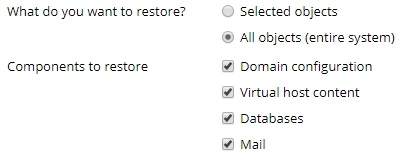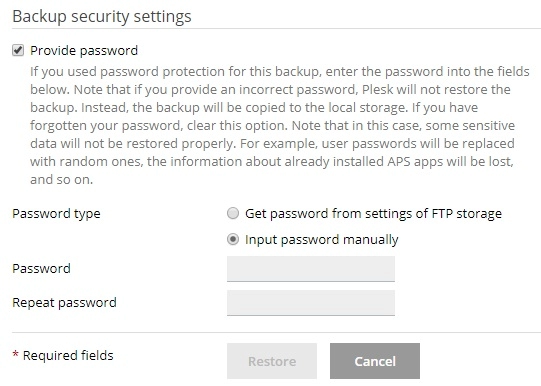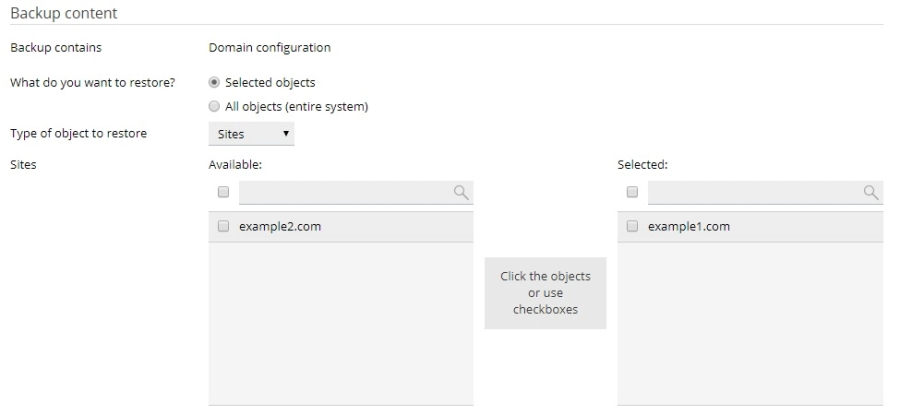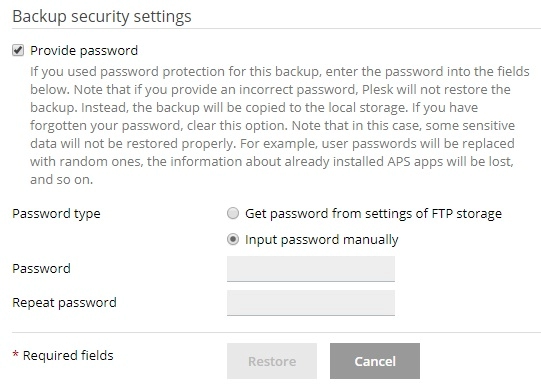If your data becomes corrupted or is accidentally lost, Plesk offers robust backup and restoration capabilities. This comprehensive guide details the process of restoring your valuable data from a backup file within Plesk Obsidian.
When performing a restoration from a backup file, you have two primary options: you can restore all data contained within the backup, or you can select specific individual objects to be restored, such as a particular website, specific databases, or individual mail accounts.
Important Note: This restoration functionality is compatible only with backups created in Plesk Onyx 17.0 and later versions. Be aware that when you restore objects from a backup, they will overwrite and replace any existing objects that share the same name. Plesk does not prompt for confirmation before an overwrite occurs. Consequently, any modifications made to these objects after the backup was initially created will be permanently lost.
Restoring All Objects from a Backup
To fully restore all objects from a comprehensive backup, follow these detailed steps:
- Navigate to Websites & Domains > Backup Manager. Here, you will find a complete list of all available backups, including those stored both on the server and within configured remote storages.
- Select the specific backup file from which you wish to initiate the restoration process.
- Under the section titled "What do you want to restore?", ensure the "All objects (entire system)" radio button is selected. This option allows for a full system recovery.
- In the "Components to restore" section, you have the flexibility to deselect checkboxes next to any classes of objects you prefer not to restore. For instance, if the "Databases" checkbox is enabled, all databases and their associated users will be restored. Clearing this checkbox will prevent any databases from being restored.

- If the backup you are restoring is protected by a password, select the "Get password from settings of Remote storage" radio button. Plesk will attempt to retrieve the password automatically. Should automatic retrieval fail (for example, if the backup originated from a different server), choose the "Input password manually" option and enter the correct password in the provided fields.

- In cases where the password cannot be automatically fetched and you do not know it, you may clear the "Provide password" checkbox. Plesk will proceed with the backup restoration, but all passwords for the restored objects (such as database users or mail accounts) will be randomly generated.
- At this stage, the backup is prepared for restoration. Before proceeding, you can configure several optional settings:
- Select the "Suspend domains until the restoration is completed" checkbox if you need to ensure the integrity and validity of the restoration process. Activating this option will temporarily make your websites unavailable, displaying a 503 HTTP status code error page to visitors until the restoration is finalized.
- Enable the "When the restoration is completed, send a notification to" checkbox if you wish to receive an email alert upon the successful completion of the restoration. Verify that the specified email address is accurate.
- Click the Restore button to commence the backup restoration.
You will be redirected to the Websites & Domains > Backup Manager screen, where you can monitor the progress of the restoration. The duration of this process varies depending on the overall size of the content being restored. A notification will appear on this screen once the backup has been successfully restored.

Restoring Individual Objects from a Backup
You are not always required to restore the entirety of the configuration and content stored within a backup file. Plesk provides the flexibility to select and restore specific individual objects from a backup, such as a single domain along with its associated elements, a particular mail account, or even just a specific file.
To restore individual objects from a backup, follow these steps:
- Access Websites & Domains > Backup Manager. Here, you will find a comprehensive list of all stored backups, including those located on the server and within remote storage locations.
- Click on the desired backup file from which you intend to restore specific objects.
- Under the "What do you want to restore?" section, select the "Selected objects" radio button to enable granular restoration.
- In the "Type of object to restore" dropdown, specify the category of objects you wish to restore:
- Mail account: For restoring specific individual email accounts.
- Database: To restore individual databases.
- Sites: To restore entire individual websites, including all associated objects and content like mail accounts and databases.
- DNS Zone: For restoring the DNS zone content for particular domains.
- Files of domains: To restore specific individual files.
Note: If your restoration task involves objects of different types (e.g., one mail account and two separate databases), you will need to perform separate restoration operations for each object type.
- Proceed to select the specific objects for restoration. All available objects of the chosen type will be displayed in the "Available" column on the left. Click on the objects you wish to restore, and they will be moved to the "Selected" column.

- If you selected "Files of domains" in the previous step, click Add files, then browse and select the specific file or files you intend to restore, and finally click OK.

- You have the option to select any number of files for restoration.
- Under the "Restore" section, choose whether to restore only the configuration of the selected objects, or both their configuration and their content.

- For example, when restoring a database, selecting only the configuration option will restore the database structure and associated database users, but not the tables or the actual data within them. If the backup file itself only contains configuration data and no content, this specific option will be unavailable.
- At this point, your selected objects are ready for restoration. You can configure a few additional optional settings before initiating the process:
- Check the "Suspend domains until the restoration is completed" box if you want to ensure the consistency of the restoration. This action will temporarily make your website inaccessible to visitors, who will see a 503 HTTP status code error page until the restoration is fully completed.
- Mark the "When the restoration is completed, send a notification to" checkbox if you wish to receive an email notification once the restoration process is finished. Double-check that the provided email address is correct.
- If the backup you are restoring is password-protected, Plesk will prompt you to provide the password. We recommend selecting the "Get password from settings of Remote storage" radio button, which will automatically retrieve a password specified in your Remote storage settings. If automatic password retrieval is not possible (e.g., if the backup was created on a different server), select the "Input password manually" radio button and accurately enter the password in the designated fields.

- Should the password not be automatically fetched and you have forgotten it, you can clear the "Provide password" checkbox. Plesk will proceed with the backup restoration, but certain data, such as all passwords within the backup database, may not be recovered properly and will be randomly generated.
- Click the Restore button to initiate the restoration process for the selected objects.
You will be directed back to the Websites & Domains > Backup Manager screen, where you can observe the progress of the restoration. The time required for this process will vary based on the volume of content being restored. A notification will confirm on this screen once the restoration is successfully completed.





